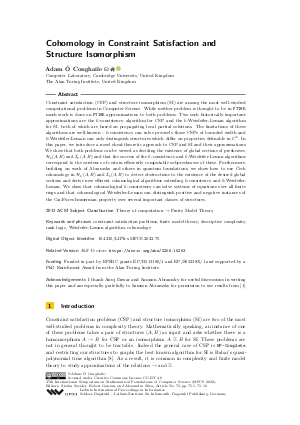LIPIcs.MFCS.2022.75.pdf
- Filesize: 0.78 MB
- 16 pages

 Creative Commons Attribution 4.0 International license
Creative Commons Attribution 4.0 International license

Constraint satisfaction (CSP) and structure isomorphism (SI) are among the most well-studied computational problems in Computer Science. While neither problem is thought to be in PTIME, much work is done on PTIME approximations to both problems. Two such historically important approximations are the k-consistency algorithm for CSP and the k-Weisfeiler-Leman algorithm for SI, both of which are based on propagating local partial solutions. The limitations of these algorithms are well-known – k-consistency can solve precisely those CSPs of bounded width and k-Weisfeiler-Leman can only distinguish structures which differ on properties definable in C^k. In this paper, we introduce a novel sheaf-theoretic approach to CSP and SI and their approximations. We show that both problems can be viewed as deciding the existence of global sections of presheaves, ℋ_k(A,B) and ℐ_k(A,B) and that the success of the k-consistency and k-Weisfeiler-Leman algorithms correspond to the existence of certain efficiently computable subpresheaves of these. Furthermore, building on work of Abramsky and others in quantum foundations, we show how to use Čech cohomology in ℋ_k(A,B) and ℐ_k(A,B) to detect obstructions to the existence of the desired global sections and derive new efficient cohomological algorithms extending k-consistency and k-Weisfeiler-Leman. We show that cohomological k-consistency can solve systems of equations over all finite rings and that cohomological Weisfeiler-Leman can distinguish positive and negative instances of the Cai-Fürer-Immerman property over several important classes of structures.





Feedback for Dagstuhl Publishing